
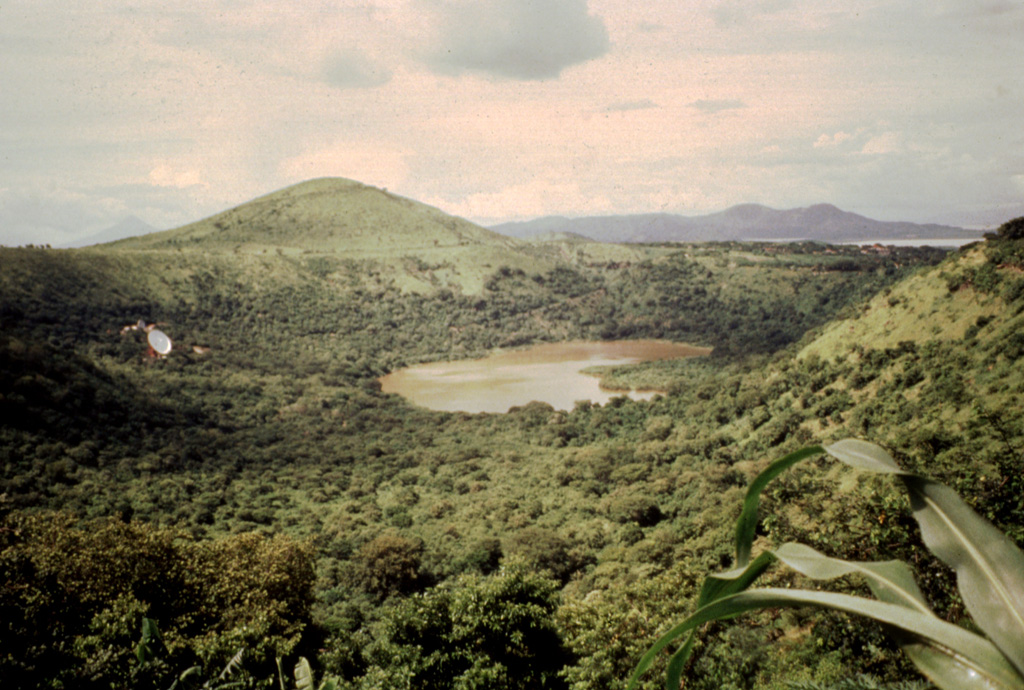
No thermal activity despite reported gas emission after early 20th century quakes
"The alignment extends from Apoyeque to Managua (figure 1) and lies on the W boundary fault of the Managua graben. Phreatomagmatic and Strombolian activity occurred during the past 30,000 years, with about 40 separate eruptions, the most recent less than 2,500 years ago. A study well drilled to 300 m in the San Carlos crater did not detect thermal activity. There were reports of gas emission after earth tremors in the early 20th century (El Heraldo, 24 October 1916) and some aftershocks of the 1972 Managua earthquake were located on the alignment."
Reference. Bice, D.C., 1980, Tephra stratigraphy and physical aspects of recent volcanism near Managua, Nicaragua: Ph.D. Dissertation, University of California, Berkeley, 422 p.
Information Contacts: B. van Wyk de Vries, O. Castellón, A. Murales, and V. Tenorio, INETER.
The Global Volcanism Program has no Weekly Reports available for Nejapa-Miraflores.
Reports are organized chronologically and indexed below by Month/Year (Publication Volume:Number), and include a one-line summary. Click on the index link or scroll down to read the reports.
No thermal activity despite reported gas emission after early 20th century quakes
"The alignment extends from Apoyeque to Managua (figure 1) and lies on the W boundary fault of the Managua graben. Phreatomagmatic and Strombolian activity occurred during the past 30,000 years, with about 40 separate eruptions, the most recent less than 2,500 years ago. A study well drilled to 300 m in the San Carlos crater did not detect thermal activity. There were reports of gas emission after earth tremors in the early 20th century (El Heraldo, 24 October 1916) and some aftershocks of the 1972 Managua earthquake were located on the alignment."
Reference. Bice, D.C., 1980, Tephra stratigraphy and physical aspects of recent volcanism near Managua, Nicaragua: Ph.D. Dissertation, University of California, Berkeley, 422 p.
Information Contacts: B. van Wyk de Vries, O. Castellón, A. Murales, and V. Tenorio, INETER.
|
|
||||||||||||||||||||||||||||
There is data available for 8 confirmed Holocene eruptive periods.
1060 ± 100 years Confirmed Eruption (Explosive / Effusive) VEI: 3 (?)
| Episode 1 | Eruption (Explosive / Effusive) | Nejapa maar | ||||||||||||||||||||||||||||||||||||||||||||
|---|---|---|---|---|---|---|---|---|---|---|---|---|---|---|---|---|---|---|---|---|---|---|---|---|---|---|---|---|---|---|---|---|---|---|---|---|---|---|---|---|---|---|---|---|---|
| 1060 ± 100 years - Unknown | Evidence from Correlation: Tephrochronology | ||||||||||||||||||||||||||||||||||||||||||||
|
List of 7 Events for Episode 1 at Nejapa maar
|
|||||||||||||||||||||||||||||||||||||||||||||
0550 BCE ± 500 years Confirmed Eruption (Explosive / Effusive)
| Episode 1 | Eruption (Explosive / Effusive) | PM5 tephra | ||||||||||||||||||||||||
|---|---|---|---|---|---|---|---|---|---|---|---|---|---|---|---|---|---|---|---|---|---|---|---|---|---|
| 0550 BCE ± 500 years - Unknown | Evidence from Correlation: Tephrochronology | ||||||||||||||||||||||||
|
List of 3 Events for Episode 1 at PM5 tephra
|
|||||||||||||||||||||||||
3050 BCE ± 500 years Confirmed Eruption (Explosive / Effusive)
| Episode 1 | Eruption (Explosive / Effusive) | PM4 tephra | ||||||||||||||||||||||||
|---|---|---|---|---|---|---|---|---|---|---|---|---|---|---|---|---|---|---|---|---|---|---|---|---|---|
| 3050 BCE ± 500 years - Unknown | Evidence from Correlation: Tephrochronology | ||||||||||||||||||||||||
|
List of 3 Events for Episode 1 at PM4 tephra
|
|||||||||||||||||||||||||
4390 BCE ± 100 years Confirmed Eruption (Explosive / Effusive)
| Episode 1 | Eruption (Explosive / Effusive) | El Hormigón | |||||||||||||||||||
|---|---|---|---|---|---|---|---|---|---|---|---|---|---|---|---|---|---|---|---|---|
| 4390 BCE ± 100 years - Unknown | Evidence from Isotopic: 14C (uncalibrated) | |||||||||||||||||||
|
List of 2 Events for Episode 1 at El Hormigón
|
||||||||||||||||||||
5230 BCE ± 200 years Confirmed Eruption (Explosive / Effusive)
| Episode 1 | Eruption (Explosive / Effusive) | TC tephra | |||||||||||||||||||||||||||||
|---|---|---|---|---|---|---|---|---|---|---|---|---|---|---|---|---|---|---|---|---|---|---|---|---|---|---|---|---|---|---|
| 5230 BCE ± 200 years - Unknown | Evidence from Isotopic: 14C (uncalibrated) | |||||||||||||||||||||||||||||
|
List of 4 Events for Episode 1 at TC tephra
|
||||||||||||||||||||||||||||||
5350 BCE ± 200 years Confirmed Eruption (Explosive / Effusive)
| Episode 1 | Eruption (Explosive / Effusive) | NNT tephra | |||||||||||||||||||||||||||||||||||||||
|---|---|---|---|---|---|---|---|---|---|---|---|---|---|---|---|---|---|---|---|---|---|---|---|---|---|---|---|---|---|---|---|---|---|---|---|---|---|---|---|---|
| 5350 BCE ± 200 years - Unknown | Evidence from Isotopic: 14C (uncalibrated) | |||||||||||||||||||||||||||||||||||||||
|
List of 6 Events for Episode 1 at NNT tephra
|
||||||||||||||||||||||||||||||||||||||||
7300 BCE ± 3150 years Confirmed Eruption (Explosive / Effusive)
| Episode 1 | Eruption (Explosive / Effusive) | PM3 tephra | ||||||||||||||||||||||||
|---|---|---|---|---|---|---|---|---|---|---|---|---|---|---|---|---|---|---|---|---|---|---|---|---|---|
| 7300 BCE ± 3150 years - Unknown | Evidence from Correlation: Tephrochronology | ||||||||||||||||||||||||
|
List of 3 Events for Episode 1 at PM3 tephra
|
|||||||||||||||||||||||||
7430 BCE ± 300 years Confirmed Eruption (Explosive / Effusive)
| Episode 1 | Eruption (Explosive / Effusive) | Refinería crater | |||||||||||||||||||||||||||||||||||||||
|---|---|---|---|---|---|---|---|---|---|---|---|---|---|---|---|---|---|---|---|---|---|---|---|---|---|---|---|---|---|---|---|---|---|---|---|---|---|---|---|---|
| 7430 BCE ± 300 years - Unknown | Evidence from Isotopic: 14C (uncalibrated) | |||||||||||||||||||||||||||||||||||||||
|
List of 6 Events for Episode 1 at Refinería crater
|
||||||||||||||||||||||||||||||||||||||||
This compilation of synonyms and subsidiary features may not be comprehensive. Features are organized into four major categories: Cones, Craters, Domes, and Thermal Features. Synonyms of features appear indented below the primary name. In some cases additional feature type, elevation, or location details are provided.
Synonyms |
||||
| Nejapa-Ticoma | Miraflores-Nejapa | ||||
Cones |
||||
| Feature Name | Feature Type | Elevation | Latitude | Longitude |
| Embajada, Cerro de la | Pyroclastic cone | |||
| Empajada, La | Pyroclastic cone | |||
| Frawley, Cerro | Pyroclastic cone | |||
| Hormigón, El | Pyroclastic cone | |||
| Km 14, Cerro | Pyroclastic cone | |||
| Motastepe, Cerro | Pyroclastic cone | 360 m | 12° 7' 34.00" N | 86° 19' 37.00" W |
Craters |
||||
| Feature Name | Feature Type | Elevation | Latitude | Longitude |
| Asososca, Laguna de | Maar | 12° 8' 10.00" N | 86° 18' 54.00" W | |
| Nejapa | Maar | 12° 7' 8.00" N | 86° 19' 0.00" W | |
| Refinería | Crater | |||
| Satélite | Crater | |||
| Ticomo
Ticoma |
Crater | 12° 6' 0.00" N | 86° 19' 0.00" W | |
| Tiscapa, Laguna de | Maar | 12° 8' 17.00" N | 86° 16' 0.00" W | |
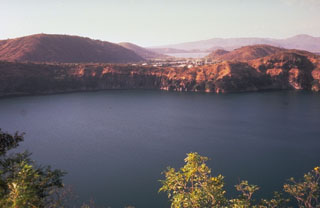 The steep-walled crater Laguna de Asososca provides water for the adjacent capital city of Managua. The elongated 1.3 x 1 km wide lake lies north of Laguna de Nejapa along the Nejapa-Miraflores lineament and is viewed here from the SE. In the background, beyond a bay of Lake Managua (the light-colored body of water at the upper right-center), is the Chiltepe Peninsula. This Laguna de Asososca is not to be confused with another crater lake of the same name at the southern end of the N-S-trending Las Pilas volcanic complex.
The steep-walled crater Laguna de Asososca provides water for the adjacent capital city of Managua. The elongated 1.3 x 1 km wide lake lies north of Laguna de Nejapa along the Nejapa-Miraflores lineament and is viewed here from the SE. In the background, beyond a bay of Lake Managua (the light-colored body of water at the upper right-center), is the Chiltepe Peninsula. This Laguna de Asososca is not to be confused with another crater lake of the same name at the southern end of the N-S-trending Las Pilas volcanic complex.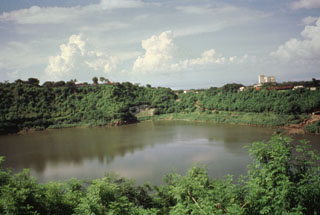 Laguna de Tiscapa is seen here from the SW with a skyscraper of downtown Managua in the right background. The 700-m-wide maar overlooks the central part of the city. Laguna de Tiscapa lies about 5 km east of the Nejapa-Miraflores crater lineament along a major fault that cuts through the city of Managua.
Laguna de Tiscapa is seen here from the SW with a skyscraper of downtown Managua in the right background. The 700-m-wide maar overlooks the central part of the city. Laguna de Tiscapa lies about 5 km east of the Nejapa-Miraflores crater lineament along a major fault that cuts through the city of Managua. Laguna de Nejapa (right center) and Cerro Motastepe (left-center horizon) are part of the N-S-trending Nejapa-Miraflores alignment. A series of pit craters and fissure vents extends into Lake Managua (barely visible at the far upper right) and is continuous with the volcanic vents on the Chiltepe Peninsula (far right horizon). The Nejapa-Miraflores alignment (also known as Nejapa-Ticoma) has been the site of about 40 eruptions during the past 30,000 years, the most recent of which (from Cerro Motastepe) occurred less than 2500 years ago.
Laguna de Nejapa (right center) and Cerro Motastepe (left-center horizon) are part of the N-S-trending Nejapa-Miraflores alignment. A series of pit craters and fissure vents extends into Lake Managua (barely visible at the far upper right) and is continuous with the volcanic vents on the Chiltepe Peninsula (far right horizon). The Nejapa-Miraflores alignment (also known as Nejapa-Ticoma) has been the site of about 40 eruptions during the past 30,000 years, the most recent of which (from Cerro Motastepe) occurred less than 2500 years ago. 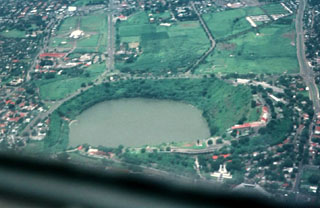 Laguna de Tiscapa partially fills a 700-m-wide maar on the outskirts of Managua, Nicaragua's capital city. The maar was constructed along a major fault that cuts through Managua. The rim of the crater overlooks the center of Managua and consequently has been the site of military fortifications dating back to the 18th century.
Laguna de Tiscapa partially fills a 700-m-wide maar on the outskirts of Managua, Nicaragua's capital city. The maar was constructed along a major fault that cuts through Managua. The rim of the crater overlooks the center of Managua and consequently has been the site of military fortifications dating back to the 18th century.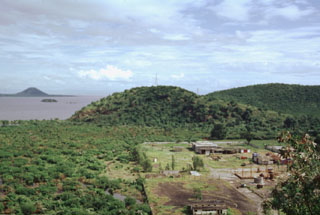 The N-S-trending Nejapa-Miraflores alignment of cones cuts across the western outskirts of the city of Managua and extends across a bay of Lake Managua onto the Chiltepe Peninsula. Cerro San Carlos (center) lies along the southern side of the bay, while the conical peak of Volcán Chiltepe is visible at the upper left on the eastern tip of the Chiltepe Peninsula.
The N-S-trending Nejapa-Miraflores alignment of cones cuts across the western outskirts of the city of Managua and extends across a bay of Lake Managua onto the Chiltepe Peninsula. Cerro San Carlos (center) lies along the southern side of the bay, while the conical peak of Volcán Chiltepe is visible at the upper left on the eastern tip of the Chiltepe Peninsula.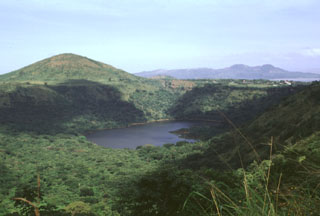 Cerro Motastepe cinder cone (upper left) is the youngest and most prominent feature of the Nejapa-Miraflores volcanic alignment. The cone, seen here from the SE with Laguna de Nejapa in the center of the photo, is elongated in an E-W direction and rises 160 m above its base to 360 m elevation. Cerro Motastepe formed less than 2500 years ago. The surface of saline Laguna de Nejapa collapse pit (center) lies at about the same level as Lake Managua, barely visible in the distance at the upper right.
Cerro Motastepe cinder cone (upper left) is the youngest and most prominent feature of the Nejapa-Miraflores volcanic alignment. The cone, seen here from the SE with Laguna de Nejapa in the center of the photo, is elongated in an E-W direction and rises 160 m above its base to 360 m elevation. Cerro Motastepe formed less than 2500 years ago. The surface of saline Laguna de Nejapa collapse pit (center) lies at about the same level as Lake Managua, barely visible in the distance at the upper right. 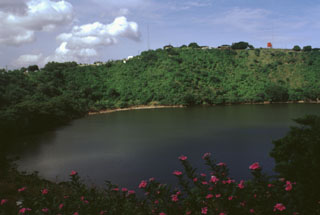 A restaurant on the rim of Laguna de Tiscapa provides a scenic view of the a 700-m-wide maar on the outskirts of Managua, Nicaragua's capital city. The maar was constructed along a major fault that cuts through Managua. The crater overlooks the center of Managua and lies 5 km east of the N-S-trending Nejapa-Miraflores lineament, a 17-km-long chain of collapse pits and cinder-spatter cones that marks a point of right-lateral offset of the Nicaraguan volcanic chain.
A restaurant on the rim of Laguna de Tiscapa provides a scenic view of the a 700-m-wide maar on the outskirts of Managua, Nicaragua's capital city. The maar was constructed along a major fault that cuts through Managua. The crater overlooks the center of Managua and lies 5 km east of the N-S-trending Nejapa-Miraflores lineament, a 17-km-long chain of collapse pits and cinder-spatter cones that marks a point of right-lateral offset of the Nicaraguan volcanic chain.There are no samples for Nejapa-Miraflores in the Smithsonian's NMNH Department of Mineral Sciences Rock and Ore collection.
| Copernicus Browser | The Copernicus Browser replaced the Sentinel Hub Playground browser in 2023, to provide access to Earth observation archives from the Copernicus Data Space Ecosystem, the main distribution platform for data from the EU Copernicus missions. |
| MIROVA | Middle InfraRed Observation of Volcanic Activity (MIROVA) is a near real time volcanic hot-spot detection system based on the analysis of MODIS (Moderate Resolution Imaging Spectroradiometer) data. In particular, MIROVA uses the Middle InfraRed Radiation (MIR), measured over target volcanoes, in order to detect, locate and measure the heat radiation sourced from volcanic activity. |
| MODVOLC Thermal Alerts | Using infrared satellite Moderate Resolution Imaging Spectroradiometer (MODIS) data, scientists at the Hawai'i Institute of Geophysics and Planetology, University of Hawai'i, developed an automated system called MODVOLC to map thermal hot-spots in near real time. For each MODIS image, the algorithm automatically scans each 1 km pixel within it to check for high-temperature hot-spots. When one is found the date, time, location, and intensity are recorded. MODIS looks at every square km of the Earth every 48 hours, once during the day and once during the night, and the presence of two MODIS sensors in space allows at least four hot-spot observations every two days. Each day updated global maps are compiled to display the locations of all hot spots detected in the previous 24 hours. There is a drop-down list with volcano names which allow users to 'zoom-in' and examine the distribution of hot-spots at a variety of spatial scales. |
|
WOVOdat
Single Volcano View Temporal Evolution of Unrest Side by Side Volcanoes |
WOVOdat is a database of volcanic unrest; instrumentally and visually recorded changes in seismicity, ground deformation, gas emission, and other parameters from their normal baselines. It is sponsored by the World Organization of Volcano Observatories (WOVO) and presently hosted at the Earth Observatory of Singapore.
GVMID Data on Volcano Monitoring Infrastructure The Global Volcano Monitoring Infrastructure Database GVMID, is aimed at documenting and improving capabilities of volcano monitoring from the ground and space. GVMID should provide a snapshot and baseline view of the techniques and instrumentation that are in place at various volcanoes, which can be use by volcano observatories as reference to setup new monitoring system or improving networks at a specific volcano. These data will allow identification of what monitoring gaps exist, which can be then targeted by remote sensing infrastructure and future instrument deployments. |
| Volcanic Hazard Maps | The IAVCEI Commission on Volcanic Hazards and Risk has a Volcanic Hazard Maps database designed to serve as a resource for hazard mappers (or other interested parties) to explore how common issues in hazard map development have been addressed at different volcanoes, in different countries, for different hazards, and for different intended audiences. In addition to the comprehensive, searchable Volcanic Hazard Maps Database, this website contains information about diversity of volcanic hazard maps, illustrated using examples from the database. This site is for educational purposes related to volcanic hazard maps. Hazard maps found on this website should not be used for emergency purposes. For the most recent, official hazard map for a particular volcano, please seek out the proper institutional authorities on the matter. |
| IRIS seismic stations/networks | Incorporated Research Institutions for Seismology (IRIS) Data Services map showing the location of seismic stations from all available networks (permanent or temporary) within a radius of 0.18° (about 20 km at mid-latitudes) from the given location of Nejapa-Miraflores. Users can customize a variety of filters and options in the left panel. Note that if there are no stations are known the map will default to show the entire world with a "No data matched request" error notice. |
| UNAVCO GPS/GNSS stations | Geodetic Data Services map from UNAVCO showing the location of GPS/GNSS stations from all available networks (permanent or temporary) within a radius of 20 km from the given location of Nejapa-Miraflores. Users can customize the data search based on station or network names, location, and time window. Requires Adobe Flash Player. |
| DECADE Data | The DECADE portal, still in the developmental stage, serves as an example of the proposed interoperability between The Smithsonian Institution's Global Volcanism Program, the Mapping Gas Emissions (MaGa) Database, and the EarthChem Geochemical Portal. The Deep Earth Carbon Degassing (DECADE) initiative seeks to use new and established technologies to determine accurate global fluxes of volcanic CO2 to the atmosphere, but installing CO2 monitoring networks on 20 of the world's 150 most actively degassing volcanoes. The group uses related laboratory-based studies (direct gas sampling and analysis, melt inclusions) to provide new data for direct degassing of deep earth carbon to the atmosphere. |
| Large Eruptions of Nejapa-Miraflores | Information about large Quaternary eruptions (VEI >= 4) is cataloged in the Large Magnitude Explosive Volcanic Eruptions (LaMEVE) database of the Volcano Global Risk Identification and Analysis Project (VOGRIPA). |
| EarthChem | EarthChem develops and maintains databases, software, and services that support the preservation, discovery, access and analysis of geochemical data, and facilitate their integration with the broad array of other available earth science parameters. EarthChem is operated by a joint team of disciplinary scientists, data scientists, data managers and information technology developers who are part of the NSF-funded data facility Integrated Earth Data Applications (IEDA). IEDA is a collaborative effort of EarthChem and the Marine Geoscience Data System (MGDS). |